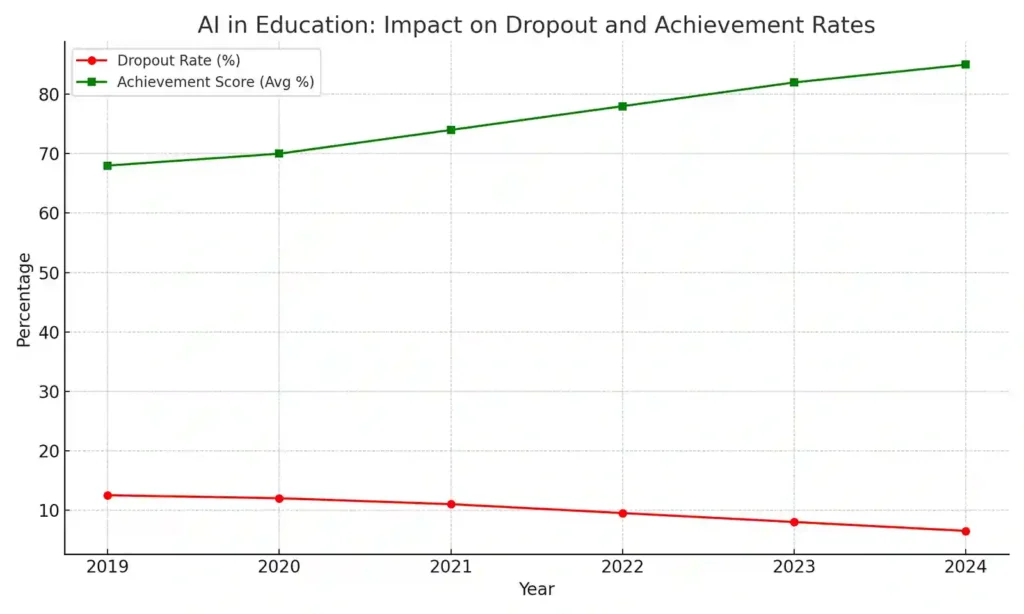Artificial Intelligence in Education
Artificial Intelligence in Education is rapidly transforming instructional models, assessment strategies, and learner engagement across academic environments. No longer confined to theoretical debate or experimental pilot programs, AI has entered mainstream educational practice with measurable outcomes.
This blog examines the current role and real impact of AI in education. It begins by defining core AI technologies and their application in classrooms. It then explores specific use cases and recent case studies that highlight improvements in student performance and instructional efficiency. Lastly, it assesses long-term implications, technical limitations, and ethical responsibilities surrounding AI integration.
The pace of adoption has accelerated. Institutions are now making data-informed decisions based on predictive algorithms. Adaptive learning tools tailor content in real time. Automated feedback systems reduce teacher workload. The question is no longer if AI will reshape education—but how well we manage that transformation.
What Is Artificial Intelligence in Education?
Artificial Intelligence in Education refers to the integration of intelligent computational systems that mimic human cognitive functions to enhance teaching, learning, and administrative processes. These systems employ advanced techniques such as machine learning, natural language processing (NLP), and generative algorithms to analyze data, interpret user input, and adapt responses accordingly.
At its core, AI in education performs four key functions:
Pattern Recognition
AI systems are designed to process vast amounts of educational data—such as quiz scores, assignment submissions, attendance records, time spent on tasks, and interaction logs from digital platforms. By identifying patterns within this data, AI can uncover subtle trends in student performance, behavioral changes, and engagement levels that may not be immediately visible to educators.
For example, a machine learning model might detect that a student’s performance in math assessments has declined steadily over three weeks, while their interaction time on the learning platform has also decreased. Simultaneously, natural language analysis of written responses may show a drop in vocabulary complexity or sentence structure. When combined, these indicators may point to disengagement or external stressors impacting learning.
Once such patterns are detected, the AI system can flag the student as potentially at risk and notify instructors or counselors. This enables timely, data-driven interventions, such as personalized learning plans, one-on-one academic support, or wellness check-ins.
In some advanced systems, predictive models also estimate future outcomes—such as the likelihood of course completion or standardized test readiness—allowing institutions to proactively support students before learning gaps widen. This shift from reactive to preventive education management is a defining strength of AI-enhanced instruction.
Decision-Making
Through predictive analytics, AI systems analyze historical and real-time data to forecast individual learner trajectories. These forecasts consider variables such as prior academic performance, content mastery levels, learning pace, engagement frequency, and even behavioral patterns on digital platforms.
Based on these insights, AI can recommend optimal instructional content and learning sequences that align with each student’s needs. For instance, if a student demonstrates strong proficiency in foundational algebra but struggles with applied problem-solving, the AI may suggest targeted modules that focus on application-based exercises before advancing to the next unit.
These recommendations are not static. As students continue to interact with the system, AI algorithms update the instructional path dynamically, ensuring continuous alignment between the learner’s evolving profile and the educational content provided. This allows educators to shift from one-size-fits-all instruction toward data-informed personalization, maximizing both efficiency and effectiveness in lesson planning.
By integrating predictive analytics into the instructional cycle, AI empowers educators to make strategic decisions that anticipate student needs rather than respond to setbacks—transforming the nature of teaching from reactive to proactive and precision-driven.
Content Generation
Artificial Intelligence in Education increasingly relies on generative models, particularly large language transformers, to streamline and enrich content delivery. These advanced AI systems are capable of producing human-like text, enabling the automated generation of instructional materials customized to individual learners.
For example, generative AI can instantly create quizzes based on classroom texts or lesson objectives, adjusting difficulty based on a student’s prior performance. It can also summarize lectures or reading assignments into digestible formats, improving comprehension for students with varying attention spans or language proficiencies.
In more advanced applications, AI can simulate interactive tutoring dialogues, responding to student questions in real time, asking follow-up questions, and even correcting misconceptions on the spot. These systems emulate the behavior of a human tutor, but scale across entire classrooms or institutions—offering on-demand, adaptive support that complements teacher instruction.
Crucially, this use of Artificial Intelligence in Education does not replace educators but enhances their capacity to meet diverse learner needs. The generative capabilities of AI reduce manual workload, increase instructional responsiveness, and enable greater personalization—especially in resource-constrained environments.
Adaptive Algorithms
A core strength of Artificial Intelligence in Education lies in its use of adaptive algorithms to deliver personalized instruction. These algorithms process continuous streams of learner input—such as quiz scores, response times, click behavior, and even patterns of hesitation—to dynamically modify both the pace and complexity of instructional material.
For instance, a student who consistently answers algebra questions correctly and quickly may be advanced to more complex problems or provided with enrichment activities. Conversely, a student struggling with foundational concepts might receive simplified explanations, scaffolded tasks, or additional practice exercises before moving forward.
Unlike traditional learning tools, which typically follow a static curriculum, AI-driven platforms respond in real time to each learner’s unique path. This creates a differentiated experience where content difficulty, delivery style, and instructional feedback are continuously aligned to the learner’s evolving profile.
The result is a scalable model of personalized education that maximizes engagement, minimizes frustration, and supports mastery-based progression. Teachers, in turn, can use these adaptive insights to identify learning gaps and refine group instruction—without having to manually track every student’s performance.
In this way, Artificial Intelligence in Education not only enhances individual outcomes but also amplifies teaching efficiency at scale.
It is important to distinguish AI from basic automation. Automation follows predefined rules to perform repetitive tasks—such as grading multiple-choice tests or sending reminders. In contrast, AI systems learn from data, refine their outputs, and make context-aware decisions without explicit reprogramming.
While automation increases efficiency, AI enhances intelligence and personalization in educational environments. This fundamental difference underscores AI’s potential to fundamentally reshape how we teach and learn.
AI Technologies Currently Used in Education
The integration of Artificial Intelligence in Education relies on a diverse set of technologies that serve both instructional and administrative functions. These tools enable real-time responsiveness, data-informed decision-making, and personalized learning experiences.
1. Natural Language Processing (NLP)
Natural Language Processing (NLP) is a subfield of artificial intelligence that enables machines to process, understand, and generate human language in a meaningful way. In the context of Artificial Intelligence in Education, NLP plays a transformative role in both instruction and assessment, enabling scalable, personalized, and linguistically responsive tools.
One of the most widely adopted applications is automated essay scoring. NLP models evaluate written responses by analyzing not just grammar and syntax, but also semantic coherence, argument structure, and lexical diversity. These systems offer consistent and unbiased evaluations, often outperforming human raters in terms of speed and reliability. Teachers can use this feedback to focus more on instructional design and less on routine grading, particularly in large or asynchronous classrooms.
Another impactful use case is chat-based virtual tutoring. NLP-powered tutors engage students in interactive dialogue, explain complex topics, and clarify misconceptions in real time. Unlike static content, these systems adjust their responses based on the learner’s input, providing tailored explanations or rephrasing concepts for better understanding. This conversational interactivity simulates the benefits of human tutoring without requiring additional teaching staff.
These tools serve a critical function in modern educational ecosystems. By leveraging Artificial Intelligence in Education through NLP, institutions can deliver high-frequency, low-latency feedback that scales to meet the demands of growing and diverse learner populations—without increasing instructor workload. Furthermore, NLP systems can support multilingual environments, offering real-time translation and language learning support, thereby enhancing accessibility and global reach.
2. Machine Learning Algorithms
Machine learning, a core discipline within Artificial Intelligence in Education, involves training algorithms to recognize patterns and make predictions based on large-scale data inputs. In educational environments, these models are central to predictive and prescriptive analytics that inform both teaching and learning.
One significant application is predictive analytics, which enables institutions to identify students who may be at risk of academic failure or dropout. By analyzing multivariate data—such as attendance records, assignment scores, quiz timings, and learning management system interaction logs—machine learning algorithms classify behavioral trends that correlate with disengagement or declining performance. Early identification facilitates timely, personalized interventions such as tutoring, counseling, or content scaffolding.
Another common use case is performance forecasting. Instructors can leverage machine-generated forecasts to anticipate how students will perform on future assessments or course milestones. This allows educators to adjust instructional pacing, revisit misunderstood topics, or assign differentiated tasks that align with individual learner profiles.
Unlike traditional analytics, machine learning dynamically refines its models over time, improving accuracy as more student data becomes available. This data-driven feedback loop supports proactive decision-making at both classroom and institutional levels, optimizing curriculum design, resource allocation, and learner outcomes.
3. Computer Vision
Computer vision, a subset of Artificial Intelligence in Education, enables machines to interpret and respond to visual data such as images and videos. By leveraging advanced image processing and neural network models, computer vision systems are increasingly being integrated into virtual and hybrid classrooms to enhance interactivity, engagement, and accessibility.
One major application is engagement monitoring. Using real-time webcam analysis, computer vision tools assess student focus through indicators like gaze direction, blink rate, and facial expressions. This data is then processed to infer attention levels or detect cognitive overload. When combined with learning analytics dashboards, these insights help instructors adjust pacing or identify when learners disengage, without the need for intrusive checks.
Another growing use case lies in accessibility solutions. Computer vision facilitates real-time sign language recognition, offering interpretation services for hearing-impaired students. Similarly, it supports object recognition to aid visually impaired learners in identifying on-screen content, diagrams, or lab tools—thereby enhancing their ability to participate fully in interactive or STEM-focused activities.
By interpreting visual behavior patterns, computer vision systems contribute to both adaptive instruction and inclusive design—two pillars of modern AI-enhanced pedagogy. As these tools mature, they promise more precise personalization and equitable learning environments across diverse educational settings.
4. Reinforcement Learning
Reinforcement learning (RL) is a critical component of Artificial Intelligence in Education, enabling systems to learn optimal instructional strategies through iterative feedback. Unlike supervised learning, which relies on labeled datasets, RL operates by rewarding correct decisions and penalizing ineffective ones—allowing AI agents to improve performance through trial and error.
In educational environments, reinforcement learning underpins adaptive learning paths. AI-powered platforms use reward-based mechanisms to determine which content a learner should encounter next. For instance, when a student answers a question correctly, the system “rewards” that pathway, signaling that the learner is ready for more complex material. Conversely, incorrect answers prompt redirection to remedial content, creating a customized sequence that evolves in real time.
A second core application is in skill mastery systems. These systems dynamically calibrate task difficulty to ensure learners remain in a state of productive struggle—challenged, but not overwhelmed. By analyzing user responses, the AI adjusts pacing, question complexity, or support levels to sustain engagement and promote long-term retention.
Reinforcement learning’s feedback-driven loop aligns closely with pedagogical theories of formative assessment and scaffolding. Its ability to individualize progression makes it especially effective in subjects that require incremental skill building, such as mathematics, programming, and language learning.
Ultimately, reinforcement learning enhances both learner autonomy and instructional efficacy, making it a foundational tool in the evolution of intelligent tutoring systems.
5. Generative AI Tools
Generative models, particularly large language transformers, are among the most transformative technologies driving Artificial Intelligence in Education today. These models are designed to produce coherent, contextually relevant language outputs, allowing them to generate educational content that is both accurate and pedagogically aligned.
One of their primary applications is in the automated creation of quizzes, practice sets, and comprehension assessments. By analyzing curriculum standards or instructional materials, generative AI can produce question banks tailored to specific grade levels, subject domains, or learning objectives. This not only reduces the workload for educators but ensures consistency across assessments.
In addition, generative models can summarize lectures, readings, or multimedia content, distilling key points into concise study aids. This capability supports information retention and time-efficient revision, particularly for students managing large volumes of academic material.
Perhaps most compelling is their use in simulated tutoring dialogues. Drawing from dialogic learning theory, AI systems can emulate Socratic questioning, offer scaffolded feedback, and personalize instruction in real-time. For example, a language model might guide a student through solving a math problem by prompting with targeted hints, mirroring one-on-one tutoring.
By adapting tone, complexity, and pacing, generative AI tools create learner-centric experiences that traditional static resources cannot. These models enable scalable personalization, offering each student a tailored interaction based on their learning style, proficiency level, or prior performance.
As generative AI continues to evolve, its integration into educational platforms will further enhance instructional design, feedback mechanisms, and content delivery—making it a cornerstone of modern Artificial Intelligence in Education.
AI in Education: Impact on Dropout and Achievement Rates

This line graph illustrates the measurable impact of Artificial Intelligence in Education on student outcomes. After AI tools were introduced—such as predictive analytics and adaptive learning platforms—dropout rates declined steadily while achievement scores in core subjects like STEM and reading improved. The data underscores AI’s potential to support retention and elevate academic performance across diverse learning populations.
Measurable Benefits of Artificial Intelligence in Education
The implementation of Artificial Intelligence in Education has led to several quantifiable improvements across instructional quality, learner performance, and operational efficiency. These outcomes are not hypothetical—they are supported by pilot programs, district-wide deployments, and academic research.
1. Enhanced Learning Outcomes in STEM and Literacy
AI-driven adaptive platforms and tutoring systems have demonstrated statistically significant gains in student achievement, particularly in math, science, and reading comprehension. These tools adjust complexity in real time, ensuring that learners operate within their optimal zone of proximal development. As a result, students often show faster conceptual mastery and higher retention rates.
2. Increased Instructional Efficiency
Educators benefit from automated grading systems, particularly for objective assessments and structured writing. This reduces turnaround time for feedback while ensuring consistency in evaluation. AI can also assist with timetabling, curriculum planning, and student grouping, allowing teachers to focus on high-impact tasks such as mentoring and differentiated instruction.
3. Customizable Pacing and Content Personalization
AI platforms use learner data to adjust both the speed and sequencing of instructional materials. For instance, students struggling with a concept may receive remedial modules, while advanced learners are fast-tracked to higher-order content. This level of personalization is not feasible in traditional classrooms without AI augmentation.
4. Improved Accessibility for Diverse Learners
Artificial Intelligence in Education also enhances inclusion. Features like real-time speech-to-text transcription, text-to-speech support, automatic sign language recognition, and translation engines remove barriers for students with disabilities or those learning in non-native languages. This broadens educational access without additional instructional burden.
5. Instructor Support Through Advanced Analytics
AI tools offer educators dashboard-based insights into student progress, engagement patterns, and at-risk indicators. By leveraging predictive analytics, instructors can preemptively intervene, adapt teaching methods, or redirect focus areas. Simultaneously, automation of repetitive administrative tasks contributes to teacher workload reduction and job satisfaction.
These measurable benefits underscore why the adoption of AI in educational contexts is accelerating. When thoughtfully integrated, Artificial Intelligence in Education complements human instruction, increases learning equity, and enables data-informed teaching at scale.
Challenges: Accuracy, Bias, and Oversight
Algorithmic bias
Artificial Intelligence in Education can unintentionally reinforce existing disparities. Predictive models may reflect socioeconomic or racial biases if trained on skewed historical data. This can lead to unfair grading, misidentification of at-risk students, or unequal access to interventions.
Model transparency
Many AI systems, especially deep learning models, operate as “black boxes.” Educators may find it difficult to understand or challenge a system’s decisions, making it hard to ensure fairness or explain outcomes to stakeholders.
Data quality
AI tools rely heavily on high-quality input. Inconsistent attendance records, incomplete grade logs, or missing behavioral data can reduce model accuracy, producing misleading insights or recommendations.
Over-reliance risk
Excessive dependence on AI systems might lead to deskilling of educators or a decrease in critical instructional judgment. Teachers could rely on AI suggestions without evaluating their pedagogical soundness, weakening the human element of education.
Technical infrastructure
Deploying AI at scale requires strong digital infrastructure, including data security, cloud storage, and high computational power. These systems are expensive and may not be feasible for underfunded institutions, leading to unequal access across districts or regions.
FAQ – Artificial Intelligence in Education
Conclusion – Real Impact, Real Responsibility
Artificial Intelligence in Education is no longer a future concept—it is actively reshaping how we teach, learn, and assess. From personalized instruction to administrative automation, AI delivers measurable value across educational levels.
However, with this progress comes the responsibility to ensure ethical use. AI systems must be transparent, equitable, and rooted in sound pedagogy. Technical advancement alone is not enough; implementation must also consider fairness, data integrity, and long-term human oversight.
As schools, educators, developers, and policymakers move forward, they must strike a careful balance between efficiency, equity, and effectiveness. The decisions made today will shape the classroom of tomorrow.
What’s your view on the real-world impact of Artificial Intelligence in Education? Share your insights in the comments.

Silvia Heart is a lifestyle and wellness writer with a background in apparel and a degree in fashion. She blends creativity with practical insights, guiding readers toward intentional, balanced living. Through her approachable style and thoughtful storytelling, Silvia inspires her community to embrace both everyday joy and personal growth.


